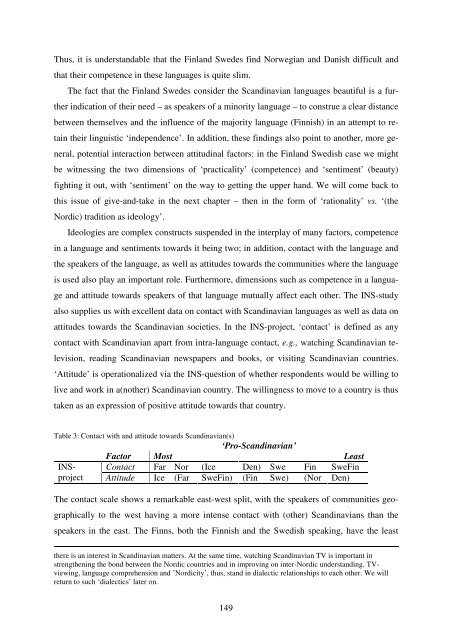Hør dog hvad de siger - Note-to-Self: Trials & Errors
Hør dog hvad de siger - Note-to-Self: Trials & Errors
Hør dog hvad de siger - Note-to-Self: Trials & Errors
Create successful ePaper yourself
Turn your PDF publications into a flip-book with our unique Google optimized e-Paper software.
Thus, it is un<strong>de</strong>rstandable that the Finland Swe<strong>de</strong>s find Norwegian and Danish difficult and<br />
that their competence in these languages is quite slim.<br />
The fact that the Finland Swe<strong>de</strong>s consi<strong>de</strong>r the Scandinavian languages beautiful is a fur-<br />
ther indication of their need – as speakers of a minority language – <strong>to</strong> construe a clear distance<br />
between themselves and the influence of the majority language (Finnish) in an attempt <strong>to</strong> re-<br />
tain their linguistic ‘in<strong>de</strong>pen<strong>de</strong>nce’. In addition, these findings also point <strong>to</strong> another, more ge-<br />
neral, potential interaction between attitudinal fac<strong>to</strong>rs: in the Finland Swedish case we might<br />
be witnessing the two dimensions of ‘practicality’ (competence) and ‘sentiment’ (beauty)<br />
fighting it out, with ‘sentiment’ on the way <strong>to</strong> getting the upper hand. We will come back <strong>to</strong><br />
this issue of give-and-take in the next chapter – then in the form of ‘rationality’ vs. ‘(the<br />
Nordic) tradition as i<strong>de</strong>ology’.<br />
I<strong>de</strong>ologies are complex constructs suspen<strong>de</strong>d in the interplay of many fac<strong>to</strong>rs, competence<br />
in a language and sentiments <strong>to</strong>wards it being two; in addition, contact with the language and<br />
the speakers of the language, as well as attitu<strong>de</strong>s <strong>to</strong>wards the communities where the language<br />
is used also play an important role. Furthermore, dimensions such as competence in a langua-<br />
ge and attitu<strong>de</strong> <strong>to</strong>wards speakers of that language mutually affect each other. The INS-study<br />
also supplies us with excellent data on contact with Scandinavian languages as well as data on<br />
attitu<strong>de</strong>s <strong>to</strong>wards the Scandinavian societies. In the INS-project, ‘contact’ is <strong>de</strong>fined as any<br />
contact with Scandinavian apart from intra-language contact, e.g., watching Scandinavian te-<br />
levision, reading Scandinavian newspapers and books, or visiting Scandinavian countries.<br />
‘Attitu<strong>de</strong>’ is operationalized via the INS-question of whether respon<strong>de</strong>nts would be willing <strong>to</strong><br />
live and work in a(nother) Scandinavian country. The willingness <strong>to</strong> move <strong>to</strong> a country is thus<br />
taken as an expression of positive attitu<strong>de</strong> <strong>to</strong>wards that country.<br />
Table 3: Contact with and attitu<strong>de</strong> <strong>to</strong>wards Scandinavian(s)<br />
‘Pro-Scandinavian’<br />
Fac<strong>to</strong>r Most Least<br />
INS- Contact Far Nor (Ice Den) Swe Fin SweFin<br />
project Attitu<strong>de</strong> Ice (Far SweFin) (Fin Swe) (Nor Den)<br />
The contact scale shows a remarkable east-west split, with the speakers of communities geo-<br />
graphically <strong>to</strong> the west having a more intense contact with (other) Scandinavians than the<br />
speakers in the east. The Finns, both the Finnish and the Swedish speaking, have the least<br />
there is an interest in Scandinavian matters. At the same time, watching Scandinavian TV is important in<br />
strengthening the bond between the Nordic countries and in improving on inter-Nordic un<strong>de</strong>rstanding. TVviewing,<br />
language comprehension and ’Nordicity’, thus, stand in dialectic relationships <strong>to</strong> each other. We will<br />
return <strong>to</strong> such ‘dialectics’ later on.<br />
149



